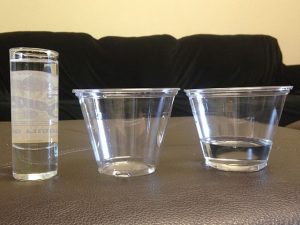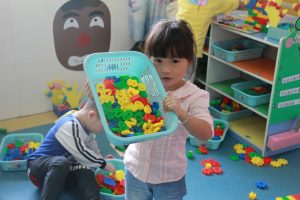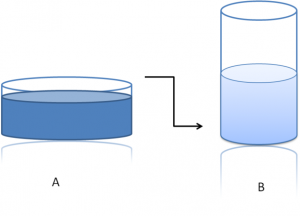Cognitive Development
Learning Objectives: Cognitive Development during Middle Childhood
- Name three major advances in cognitive development that occur with the shift to concrete operational thinking.
- What do these developments allow that thinking during the preoperational stage did not?
- Provide some examples of how concrete operational thought is seen in children’s everyday functioning during middle childhood.
- What are the limitations of concrete operational thought?
Recall from the last chapter that during early childhood children are in Piaget’s preoperational stage, and during this stage, children are learning to think symbolically about the world. As children continue into elementary school, they develop the ability to represent ideas and events more flexibly and logically. Their rules of thinking still seem very basic by adult standards and usually operate unconsciously, but they allow children to solve problems more systematically than before, and therefore to be successful with many academic tasks. In the concrete operational stage, for example, a child may unconsciously follow the rule: “If nothing is added or taken away, then the amount of something stays the same.” This simple principle helps children to understand certain arithmetic tasks, such as in adding or subtracting zero from a number, as well as to do certain classroom science experiments, such as ones involving judgments of the amounts of liquids when mixed. Piaget called this period the concrete operational stage because children mentally “operate” on concrete objects and events.
Concrete Operational Thought
From ages 7 to 11, children are in what Piaget referred to as the concrete operational stage of cognitive development (Crain, 2005). This involves mastering the use of logic in concrete ways. The word concrete refers to that which is tangible; that which can be seen, touched, or experienced directly. The concrete operational child is able to make use of logical principles in solving problems involving the physical world. For example, the child can understand principles of cause and effect, size, and distance.
The child can use logic to solve problems tied to their own direct experience, but has trouble solving hypothetical problems or considering more abstract problems. The child uses inductive reasoning, which is a logical process in which multiple premises believed to be true are combined to obtain a specific conclusion. For example, a child has one friend who is rude, another friend who is also rude, and the same is true for a third friend. The child may conclude that friends are rude. We will see that this way of thinking tends to change during adolescence as deductive reasoning emerges. We will now explore three of the major capacities that the concrete operational child exhibits.
Thought becomes multidimensional. Concrete operational children no longer focus on only one dimension of any object (such as the height of the glass) and instead can coordinate multiple dimensions simultaneously (such as the width of the glass). (That is, they are no longer limited by centration, which is why this gain is also known by the term “decentration”). Multidimensionality allows children to take multiple perspectives at the same time, to understand part-while relationships, and to cross classify objects using multiple features.

- Multiple perspectives. Remember our discussion of pre-operational thought– when young children were asked to describe the Three Mountain display from the perspective of someone sitting across the table form them? They could only report on the view form one perspective– their own. With the emergence of connote operations, children can now understand that people looking from different vantage points, see different features. They can coordinate multiple perspectives. This skill is very useful, and can be practiced, while playing with peers and settling peer disputes.
- Part-whole relationships. Think back to preoperational thought, where if you showing a long child a bouquet of six daisies and 3 roses, and asked them whether there were more daisies or flowers, they would typically answer”daisies”? They could not coordinate the two perspectives of “part” and “whole.” Now in middle childhood, these questions seem silly– of course there are more flowers, flowers include both daisies and roses. At the age, the correct answer is obvious– it’s a logical necessity.
- Classification. As children’s experiences and vocabularies grow, they build schemata and are able to organize objects in many different ways. They also understand classification hierarchies and can arrange objects into a variety of classes and subclasses.

Thought becomes operational. A second major shift in cognitive development during middle childhood coccus when thought becomes operational, by which Piaget meant that it consists of reversible, organized systems of mental actions. These systems allow children to mentally undo actions (reversibility) and to understand that certain properties of objects (like their number, mass, volume, and so on) remain constant despite transformations in appearance (conservation).

- Reversibility. The child learns that some things that have been changed can be returned to their original state. Water can be frozen and then thawed to become liquid again, but eggs cannot be unscrambled. Arithmetic operations are reversible as well: 2 + 3 = 5 and 5 – 3 = 2. Many of these cognitive skills are incorporated into the school’s curriculum through mathematical problems and in worksheets about which situations are reversible or irreversible.
- Conservation. Remember the example in our last chapter of preoperational children thinking that a tall beaker filled with 8 ounces of water was “more” than a short, wide bowl filled with 8 ounces of water? Concrete operational children can understand the concept of conservation which means that changing one quality (in this example, height or water level) can be compensated for by changes in another quality (width). Consequently, there is the same amount of water in each container, although one is taller and narrower and the other is shorter and wider.

Thought becomes logical. A third major accomplishment of concrete operational development is that thought becomes logical, and children can reason logically about concrete events.
- Inferring higher-order characteristics. Where young children’s reasoning was focused on perceptual cues, older children can now consider a variety of specific cues and from, use the power of inference, to reach a logical conclusion about higher-order characteristics. This capacity is seen in children’s understanding of their own and other people’s capacities and personalities. For example, after a child does well on multiple multiple assignments in math, she may conclude that she is high in math ability.
- Identify defining features. Whereas young children’s understanding was dominated by the most perceptually salient features of objects, with concrete operational thought, children in middle childhood focus instead on the defining features of particular objects or states. They are not distracted by the most salient features; they recognize the underlying defining features. For example, young children might think that bicycles and toasters are alive (a kind of thought called “animism,” remember?) because they move. By middle childhood, however, children understand that even though many mechanical devices (e.g., cars, fireworks) and natural objects move (e.g., the sun, the tides), only plants and animals have a life force, which is the defining feature of being alive.
- Seriation. Arranging items along a quantitative dimension, such as length or weight, in a methodical way is now demonstrated by the concrete operational child. For example, they can methodically arrange a series of different-sized sticks in order by length. This is a complicated task that requites multidimensional thinking, because each object must be placed so that it is bigger than the one before it, but smaller than the one after it. These capacities allow children to make social comparisons as well, estimating who is bigger or better along some attribute or capacity (e.g., spelling ability, soccer skills, drawing). Social comparison plays a role in the shift in children’s estimates of their capacities; they change from the rosy overestimates of early childhood (where everyone sees themselves as “good” at everything regardless of performance) to a more accurate view that corresponds to external referents (e.g., school grades) during middle childhood.

- Transitive inference. Being able to understand how objects are related to one another is referred to as transitivity, or transitive inference. This means that if one understands that a dog is a mammal, and that a poodle is a dog, then a poodle must be a mammal.

Limitations of concrete operational thought. These new cognitive skills increase the child’s understanding of the physical world, however according to Piaget, they still cannot think in abstract ways. Additionally, they do not think in systematic scientific ways. For example, when asked which variables influence the period that a pendulum takes to complete its arc and given weights they can attach to strings in order to do experiments, most children younger than 12 perform biased experiments from which no conclusions can be drawn (Inhelder & Piaget, 1958).
References
Crain, W. (2005). Theories of development (5th ed.). Upper Saddle River, NJ: Pearson.
Inhelder, B., & Piaget, J. (1958). The growth of logical thinking from childhood to adolescence. New York: Basic Books.
OER Attribution:
“Lifespan Development: A Psychological Perspective, Second Edition” by Martha Lally and Suzanne Valentine-French is licensed under a CC-BY-NC-SA-3.0
“Educational Psychology” by Kevin Seifert, OpenStax CNX, is licensed under a Creative Commons Attribution License 3.0 license / One sentence rephrased /Download for free at http://cnx.org/contents/ce6c5eb6-84d3-4265-9554-84059b75221e@2.1.
“Understanding the Whole Child: Prenatal Development Through Adolescence” by Jennifer Paris, Antoinette Ricardo, and Dawn Rymond, College of the Canyons is licensed under CC BY 4.0 / A derivative from the original work
Cognitive Development in Childhood by Boundless is licensed under CC BY-SA 4.0
Media Attributions
- 640px-Conservation2 © Waterlily16 is licensed under a CC BY-SA (Attribution ShareAlike) license
- snowflake_puzzle_nursery_play_toys-1365697.jpg!d is licensed under a CC0 (Creative Commons Zero) license
- 23746727113_8d110feafd_w © John Liu is licensed under a CC BY (Attribution) license
- Conservation_of_Liquid © Ydolem2689 is licensed under a CC BY-SA (Attribution ShareAlike) license
- 556px-Seriation_task_w_shapes © MehreenH is licensed under a CC BY-SA (Attribution ShareAlike) license
- ezequiel-garrido-Gj7mfnSqzvE-unsplash © Ezequiel Garrido is licensed under a CC0 (Creative Commons Zero) license

